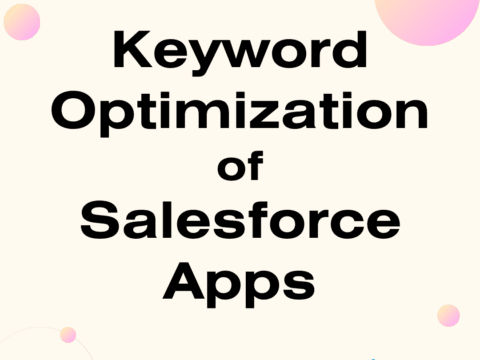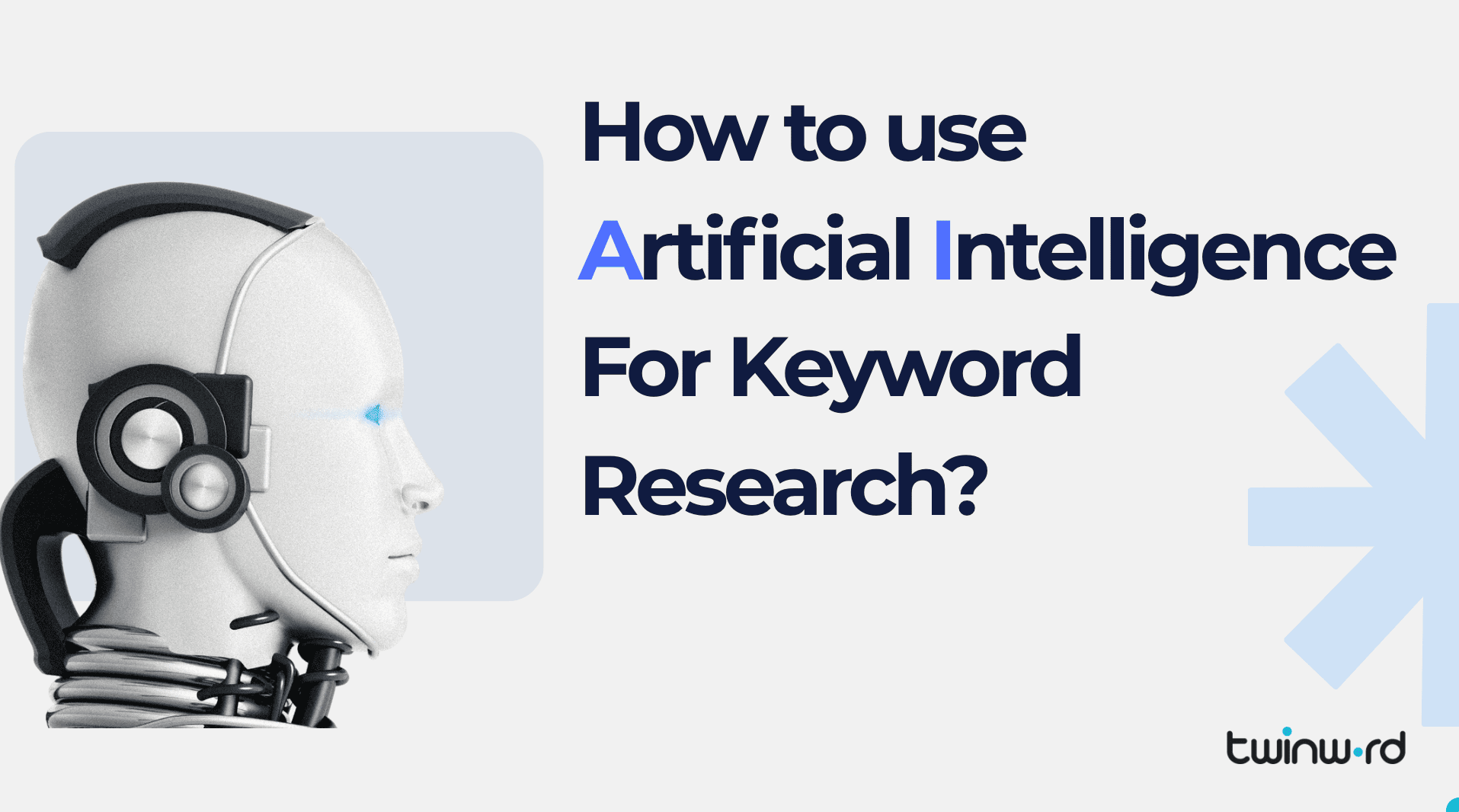
Generative AI is changing the way marketers discover and select keywords, making the process smarter, faster, and more precise. AI can now analyze search patterns, competitor websites, and real-time trends to uncover high-impact, relevant, and timely keywords that might otherwise be missed.
This guide explores several useful ways AI enhances the keyword research process, from automating seed keyword generation to identifying emerging trends, clustering related terms, and mining competitor keywords.
If you’re looking to upgrade your keyword research workflow, these AI-powered approaches offer practical ways to find the right keywords faster and more efficiently.
Let’s dive in!
14 use cases of AI in the keyword research process
Below, we break down 14 key workflows in the keyword research process and how AI can supercharge them. Each section highlights how AI makes these tasks more efficient and delivers strategic, high-quality keyword selection.
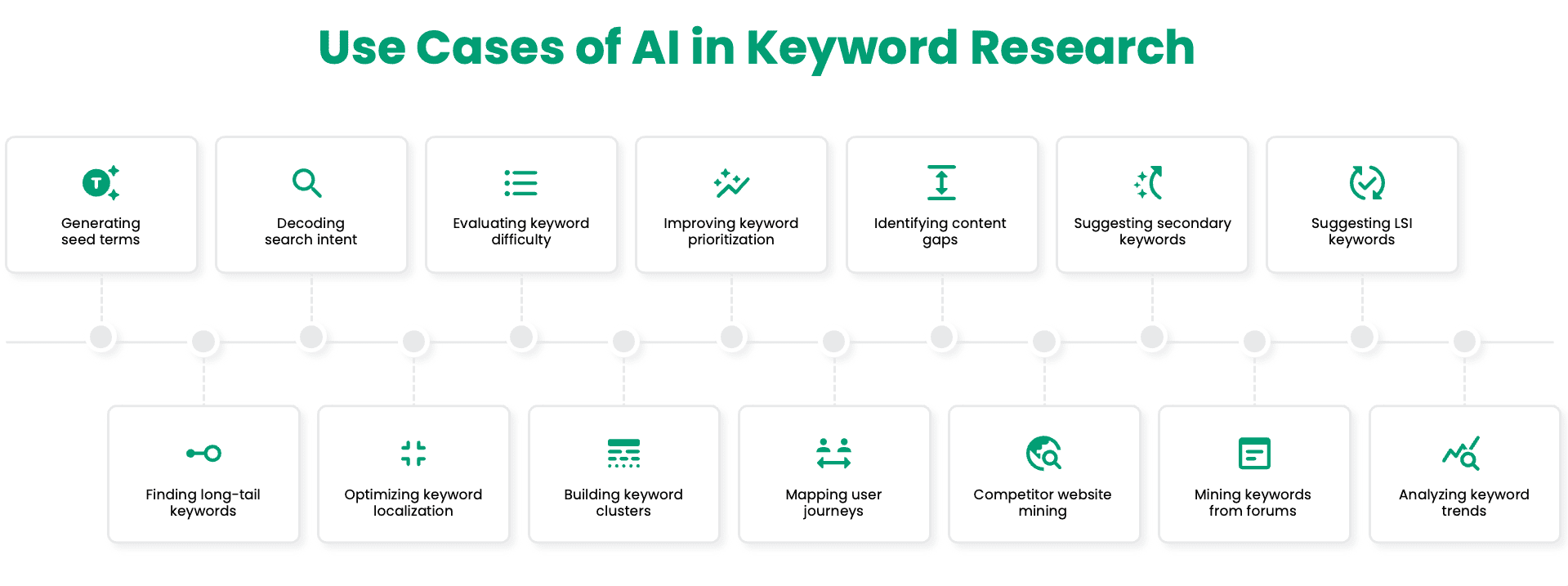
#1 Generating seed terms to feed into your keyword research tool
Effective keyword research begins with a solid foundation—the right seed keywords. These are the fundamental terms that define your niche, guiding your deep dive into keyword expansion and competitive analysis. The quality of these starting terms directly impacts your content strategy—get them right, and you pave the way for relevant, high-intent keyword opportunities. On the flip side, a weak seed list can derail your efforts, leading to misaligned content and wasted SEO resources.
Traditionally, coming up with seed terms meant manual brainstorming, studying competitor content, or sifting through industry forums. While valuable, this approach is time-consuming and limited by human bias. AI eliminates these constraints by rapidly analyzing vast amounts of contextual data—your website copy, product descriptions, industry trends, and even search intent patterns, to generate an initial list of highly relevant seed keywords.
While AI-generated seed keywords offer a fast and effective kickoff, don’t rely solely on them. Manual brainstorming remains valuable for incorporating your unique industry insights and creative flair. Use the AI-generated list as a foundation—a springboard to further refine and expand your keyword set.
Tool tip: Once you have an initial set of seed keywords, leverage a professional keyword research tool like Twinword Ideas to expand and refine them further. Twinword’s AI-driven keyword tool goes beyond basic suggestions by analyzing user intent and contextual meaning, helping you discover more targeted, high-value keywords for your content strategy.
#2 Uncovering high-intent long-tail keywords
Long-tail keywords—longer, more specific search queries—are crucial for modern SEO. They reflect user intent more precisely, attract highly targeted traffic, and often have lower competition than short, generic keywords. They also cater to voice search and conversational queries, which are becoming more common.
AI can not just generate longer keyword variations—it analyzes search behavior, user intent, and contextual meaning to surface keywords that align with real-world needs. By processing vast amounts of search data, AI can detect patterns in how users phrase their questions, what pain points they express, and how they describe the solutions they seek. It helps marketers move beyond keyword lists and towards understanding the job the user is trying to accomplish.
For example, instead of simply suggesting “email marketing software,” AI might identify solution-driven long-tail keywords like:
- “Best email marketing tool for e-commerce stores” (addresses a business-specific need)
- “Automated email campaigns for abandoned carts” (focuses on a problem businesses face)
- “How to improve email open rates for fashion brands” (targets a precise pain point)
While AI accelerates keyword discovery, it’s important to validate AI-generated keywords before using them. Some may lack meaningful search volume, be too niche, or not fully align with a brand’s offerings.
#3 Uncovering precise keyword search intent for targeted content
Accurate keyword search intent classification is vital to effective SEO and content marketing. Knowing precisely why users are searching a particular keyword allows marketers to create content tailored to the user’s expectations—whether informational, navigational, or transactional. Without clear intent classification, efforts can be misdirected, wasting resources on content that doesn’t align with user needs or search engine expectations.
AI automates intent classification by analyzing search patterns, linguistic cues, and semantic relationships. For example, Twinword’s AI can automatically classify keywords into intent categories—Know (informational), Buy/Do (transactional), and Local (navigational).
Keep in mind that AI may misclassify mixed-intent keywords, such as “best running shoes,” which could be both informational and transactional. Human review ensures AI-generated classifications align with real-world search behavior.
#4 Optimizing multilingual SEO strategy with keyword localization
Expanding into global markets requires more than direct translation. Search behaviors, cultural context, and language nuances vary across regions. A keyword that works in one language may not match user intent in another. Proper multilingual keyword research improves international visibility, organic traffic, and engagement. Without localization, brands risk using ineffective keywords that don’t align with actual search behavior.
AI automates multilingual SEO by translating and adapting keywords based on search intent, regional trends, and linguistic variations. It detects differences in how users search across countries, ensuring localized accuracy. For example, in Spanish, “zapatos deportivos” (sports shoes) is common in Mexico, but in Spain, users might search for “zapatillas de deporte.”
Twinword’s AI makes multilingual keyword research much simpler, covering over 40 languages and 200+ regional settings. Instead of relying on direct translation, it helps marketers find the right keywords for specific markets, ensuring their SEO strategy is both linguistically and culturally relevant.
#5 Evaluating keyword difficulty with in-depth SERP analysis
Choosing the right keywords is not just about search volume; it’s about assessing ranking potential. A keyword with high search traffic may be too competitive if top-ranking pages are well-established and authoritative. Conversely, some keywords that seem difficult based on traditional scores might still present opportunities if existing content is outdated, weak, or misaligned with search intent.
AI improves keyword difficulty analysis by moving beyond static difficulty scores and analyzing actual ranking content to detect weaknesses and gaps. Instead of solely relying on domain authority or backlink metrics, AI evaluates the quality, depth, and relevance of existing content. It can scan ranking pages to determine if they are thin, outdated, or poorly optimized, revealing opportunities that may not be obvious from a numerical difficulty score alone. This allows marketers to make more strategic, data-backed decisions rather than dismissing keywords purely based on traditional difficulty metrics.
#6 Building keyword clusters with AI-powered grouping
Keyword clustering helps SEO professionals create well-structured content strategies by grouping related keywords. Instead of targeting isolated keywords, clustering allows for broader topical coverage, better internal linking, and stronger semantic relevance. This improves rankings and user experience by ensuring content aligns with multiple related search queries.
AI automates keyword clustering by analyzing semantic relationships between keywords rather than relying on exact-match terms. Instead of manually sorting keywords, AI detects patterns in search intent, topic similarity, and contextual meaning to form meaningful clusters.
For example, Twinword’s AI can automatically group keywords by detecting user intent and topical similarity. It goes beyond exact keyword matching, using natural language processing (NLP) to recognize conceptual connections between keywords. This eliminates the need for manual sorting and ensures marketers receive structured keyword clusters that reflect real user search behavior.
#7 Maximizing SEO impact with keyword prioritization
With thousands of potential keywords available, prioritization is crucial to focus efforts on terms that offer the best balance of search volume, competition, and business value. Without a structured approach, marketers risk wasting time on keywords that are too competitive, have low conversion potential, or don’t align with their business goals.
AI improves keyword prioritization by understanding both the business and the keyword landscape. Instead of just ranking keywords based on static metrics like search volume and difficulty, AI analyzes what the brand is offering, the audience it is targeting, and the content it has already covered. This allows AI to not only rank keywords by relevance and opportunity but also suggest the best next steps in a content strategy. If a website already ranks well for a topic, AI may recommend supporting content rather than targeting the same keywords. If gaps exist, AI can suggest new high-impact keywords that align with both search trends and business priorities.
AI-powered prioritization is a powerful tool, but human oversight is still key. Some AI-recommended keywords may require additional context or adjustments to fit specific brand messaging and goals. A combined approach ensures that SEO efforts stay both data-driven and strategically aligned.
#8 Optimizing content engagement with user journey mapping
In SEO, not all keywords serve the same purpose—some attract early-stage researchers, while others target users ready to convert. Without mapping keywords to the user journey, brands risk misaligning content with searcher needs, leading to poor engagement and lost conversions.
AI enhances user journey mapping by analyzing search queries, intent signals, and behavioral patterns to classify keywords into different funnel stages. It identifies informational queries at the awareness stage, where users are seeking broad insights. It recognizes comparative and problem-solving searches in the consideration stage, where users are evaluating options. It detects transactional queries at the decision stage, where users are ready to take action. AI does this by studying the language and context of search terms, recognizing patterns in user behavior, and assessing how similar queries have performed in search results.
AI provides a strong framework for keyword mapping, but human oversight is still necessary. Some keywords serve multiple purposes depending on the searcher’s intent, and AI may not always capture industry-specific nuances.
#9 Enhancing SEO strategy with content audit and gap identification
A content audit is essential for understanding how existing website content performs and whether it effectively covers key topics. Websites risk keyword cannibalization, outdated information, and missed ranking opportunities without regularly assessing content. Identifying content gaps ensures valuable topics aren’t overlooked, helping brands improve search visibility and user engagement. A manual audit is time-consuming and often misses hidden gaps where competitors are outperforming.
AI improves content audits by analyzing website content against SEO performance metrics, search trends, and competitor data. It scans existing pages to assess factors like keyword coverage, relevance, and engagement. It identifies underperforming content that may need updates or consolidation and highlights opportunities where new content could fill gaps. AI also compares a site’s keyword footprint with competitors, revealing missing topics that could improve rankings.
#10 Uncovering competitor strategies with website keyword mining
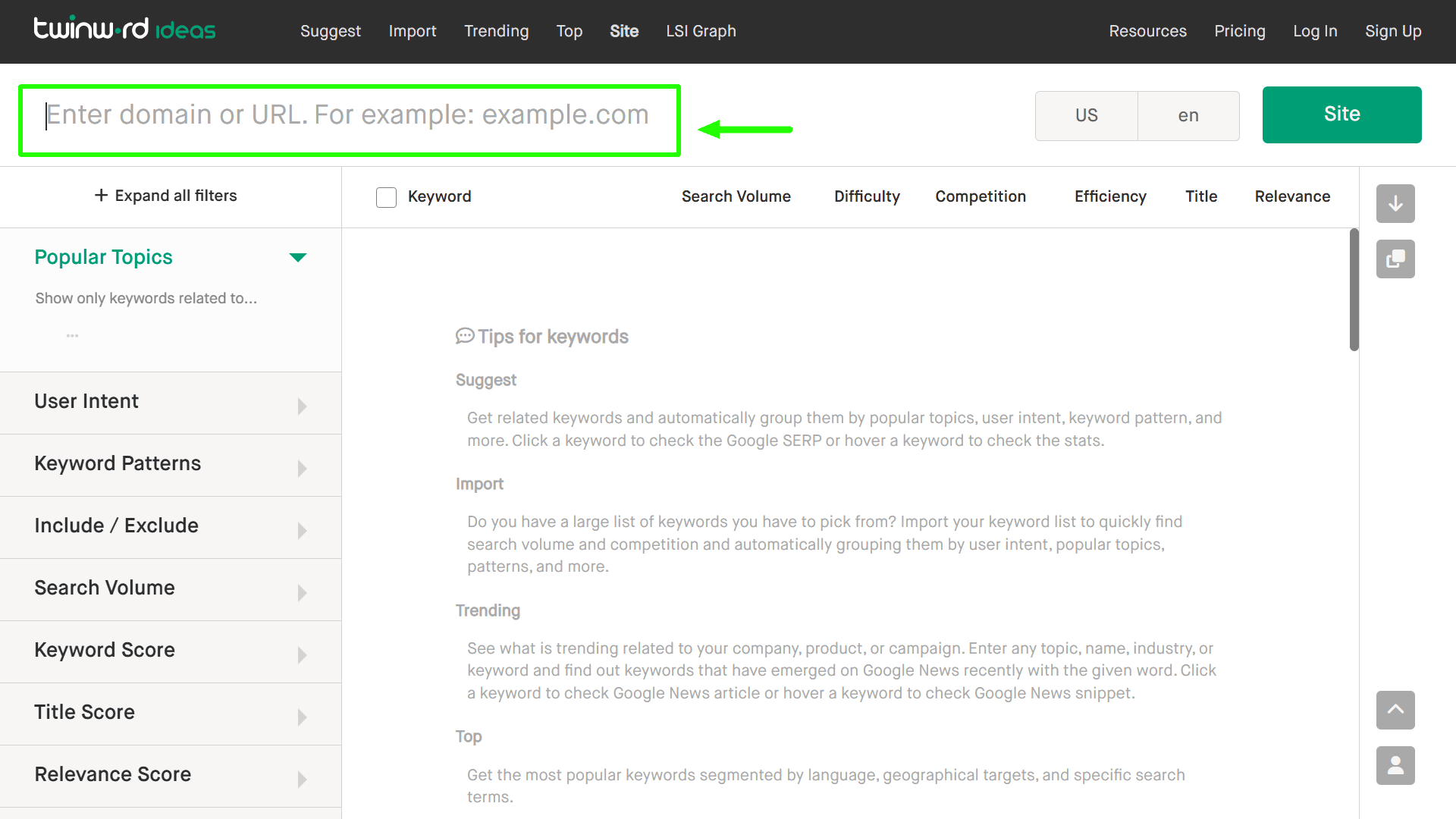
Understanding which keywords drive traffic to competitor websites helps refine SEO and PPC strategies. Analyzing competitor keyword usage reveals high-performing terms, content gaps, and ranking opportunities. Without an efficient method, extracting these insights manually is slow and incomplete.
AI can automate competitor keyword mining by extracting ranking keywords from competitor websites, PPC ads, and meta descriptions. It identifies which terms contribute to their organic and paid search success, providing a structured view of their keyword strategy.
For example, Twinword’s Site tool analyzes competitor domains or URLs to generate a keyword list reflecting their search strategy. Instead of manually scraping pages or relying on estimates, the tool delivers real data on the terms competitors actively target. This helps marketers make informed decisions on which keywords to adopt, optimize for, or compete against.
#11 Enriching content with secondary keyword ideas
Secondary keywords complement primary keywords by enhancing content depth and capturing additional search traffic. They help pages rank for multiple variations of a search query while reinforcing topical relevance. Without strategically chosen secondary keywords, content may miss ranking opportunities for closely related search terms, limiting visibility and engagement.
Instead of manually brainstorming variations, AI can scan search data to identify terms that align with the primary keyword’s intent. It detects synonyms, alternative phrasings, and commonly searched variations, ensuring content naturally incorporates the most relevant supporting terms. AI also distinguishes between secondary keywords (keywords meant to be ranked for) and semantic keywords (conceptually related but not necessarily ranking targets), helping marketers build structured keyword groups that maximize search potential.
For example, if the primary keyword is “what is SEO,” AI may suggest secondary keywords like “SEO definition,” “meaning of SEO,” “what does SEO stand for,” and “what is search engine optimization.” These terms share the same search intent but are phrased differently, allowing content to rank for multiple variations.
#12 Extracting high-value keywords from forum and social media content mining
Platforms like Reddit, Quora, Twitter, and Facebook groups are rich sources of keywords that reflect how real users discuss topics, ask questions, and seek solutions. These platforms provide access to unfiltered, intent-driven language that people use naturally, making them valuable for uncovering long-tail keywords, emerging trends, and niche-specific queries.
AI tools can perform keyword mining from forums and social media by scanning discussions, detecting frequently mentioned terms, and analyzing user intent. For example, AI can analyze Reddit discussions in subreddits like r/SEO or r/ecommerce to surface commonly asked questions, such as “how to improve Shopify SEO” or “best tools for backlink analysis.” On LinkedIn, it can extract highly searched industry-specific queries that are structured in a way searchers naturally phrase them.
#13 Enhancing content relevance with LSI keyword discovery
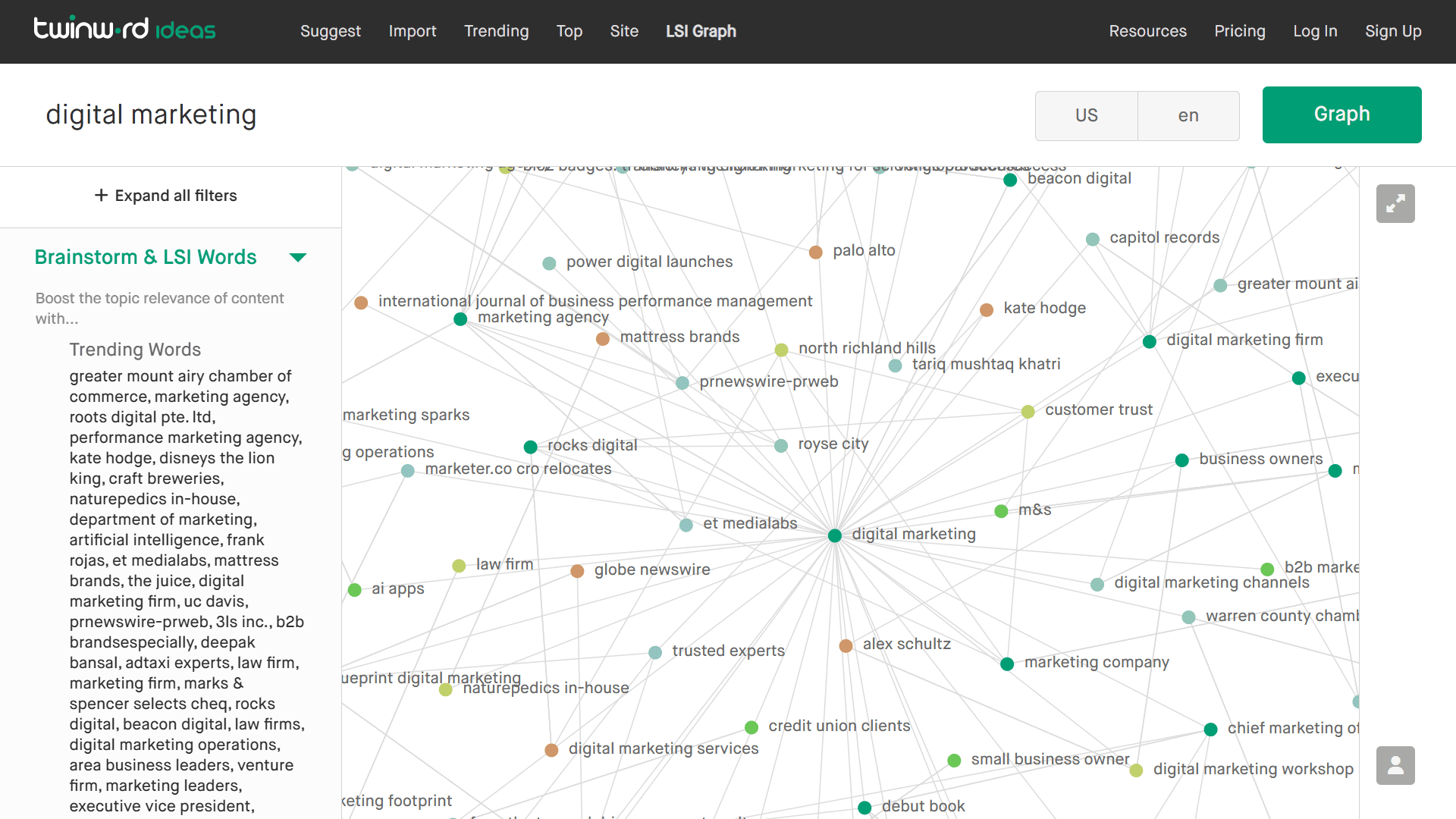
Latent Semantic Indexing (LSI) keywords are semantically related terms that help search engines understand content in a broader context. Unlike direct keyword synonyms, LSI keywords establish thematic relevance, ensuring that content aligns with how search engines interpret user queries.
For example, with Twinword’s LSI Graph tool, you can visually see how terms are connected to your main keyword. This allows marketers to instantly identify strong semantically related terms and incorporate them naturally into content. Instead of manually researching relationships between words, the LSI Graph provides a clear, AI-generated map of contextual connections that align with search engine expectations.
#14 Identifying emerging keyword opportunities with trend analysis
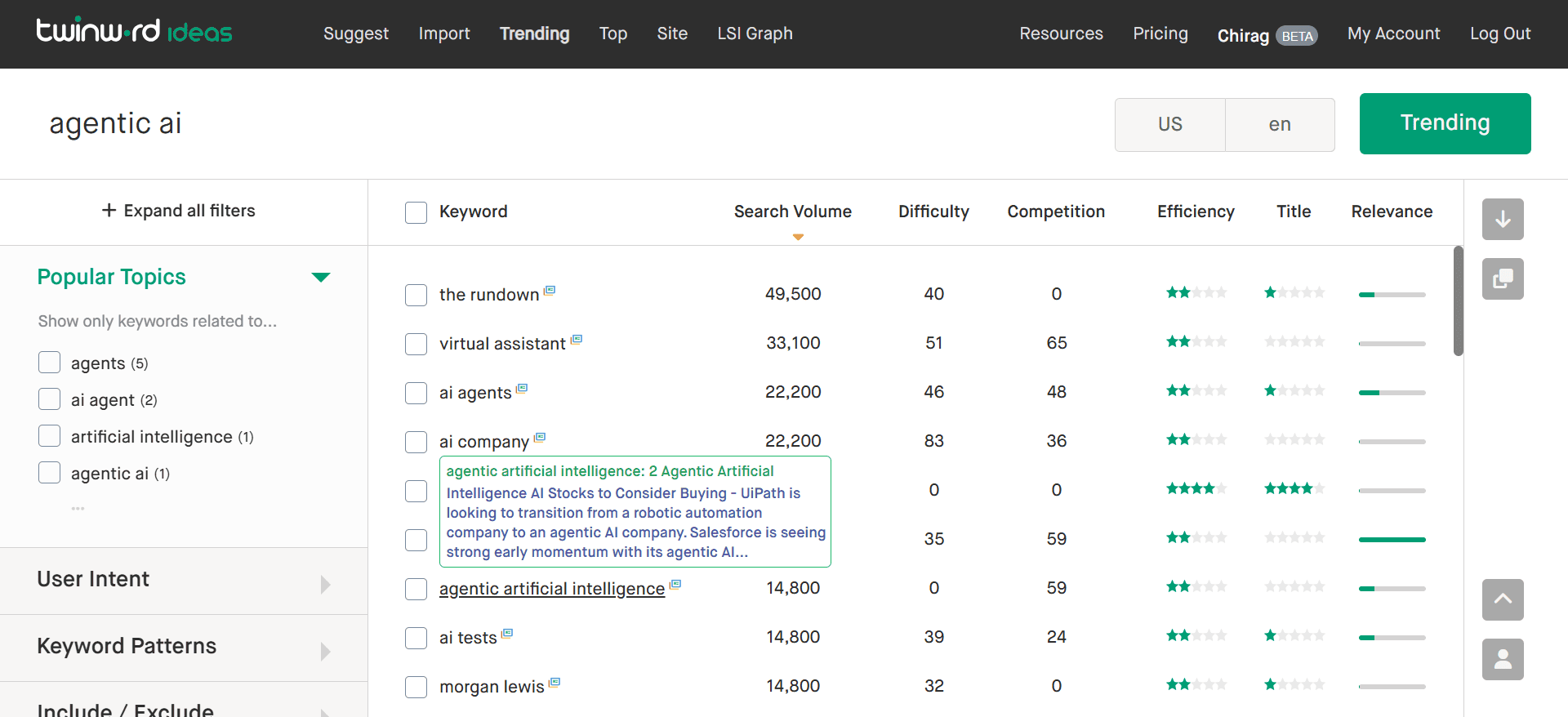
Search trends evolve rapidly, and staying ahead of emerging keywords is essential for maintaining search visibility. Trending keywords reflect shifting user interests, industry developments, and viral topics, making them critical for content marketers and SEO professionals who want to capitalize on high-traffic opportunities.
AI improves trend-based keyword discovery by scanning news sources, social media, and search engine data to detect rising search terms before they peak in popularity. With Twinword’s Trending Tool, businesses can track real-time keyword trends related to their industry, brand, or campaign. By entering a topic or keyword, users can instantly discover which search terms have recently emerged in Google News and explore how these terms are being used in the latest articles. Further, you can check out these Google News keyword research hacks to find high-impact search terms.
Next steps: Supercharge your keyword research tasks with the right AI tool
AI is no longer an option in keyword research—it’s a competitive advantage. The ability to analyze search intent, uncover hidden opportunities, and adapt to evolving trends at scale gives AI-powered tools an edge over traditional keyword research methods.
Start by examining your current keyword research workflow and identify areas where manual effort is slowing you down or limiting insights. Whether it’s clustering keywords, analyzing search intent, or tracking competitor terms, AI can help automate these tasks while providing smarter, data-backed recommendations.
To apply AI effectively, you need the right tool. Twinword is a robust AI-powered keyword research platform designed to support many of the workflows covered in this guide. From automatic keyword grouping to LSI keyword discovery, Twinword helps marketers find, refine, and prioritize keywords with greater accuracy and efficiency.
Try Twinword for free today and start making AI an essential part of your keyword research strategy.



